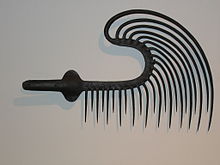Eel catch
Eel trapping refers to the fishing of eels using different methods or fishing techniques. Depending on the body of water and the type of eel, one or the other method has proven to be more successful.
Fishing methods
Some of the following methods have now been banned:

- with eel traps (baskets or nets) - because they are easy to handle, they are an important fishing method, especially for professional fishermen. However, when laying out the baskets, you need to have local knowledge in order to know where eels often stay.
- Eel fishing with trawls is usually only possible in larger bodies of water in which fishing rights are not divided.
- with eel chocolate core (special boat for catching eels near the coast or on rivers)
- Electrofishing
- using eel lip and plumper stick
- with the so-called pöddern , in which a very simple device without a fishhook is used
- with eel line - is particularly suitable for the hobby angler, as larger yields are not to be expected. The disadvantage is that even small animals - which are not yet suitable for smoking - are caught. Small fish such as roach , rudd and bream , as well as worms, bee maggots or tebo larvae ( Chilecomadia moorei ) can serve as bait .
- with eel pupae - floating bodies with fishing line floating over a body of water
- Stationary fishing systems, Aalhamen (permanently installed nets) are particularly suitable for an inventory and less for the management of a larger body of water.
- with eel sticks (also called eel forks, eel spears or eel scissors) - trident-like skewers with mostly three- or five-pointed ends attached to a long stick. This fishing method has been banned since the 1950s.
- with eel rakes - rake-shaped devices that were pulled through the silt and on whose prongs the eels hidden in the silt were impaled. This fishing method has been banned since the 1920s.
- with eel trapping , mostly wooden, fixed installations at the drain / weir of dammed (mill) ponds to catch the eels swimming through them, in particular to catch the eels in them when the pond water is occasionally or regularly drained
According to unofficial estimates, around 30,000 tonnes were caught annually by around 20,000 to 25,000 fishermen in the 1990s.
threat
The European eel ( Anguilla anguilla ), once a fish found in abundance in rivers, has been an endangered animal on the Red List for years . There are many reasons for that:

- For example, the parasite Anguillicoloides crassus damages the swim bladder of the eels and they are no longer able to cope with the exhausting journey through the Atlantic. 90% of the eels are now infected. The high environmental pollution can certainly be discussed as a reason for the poor general condition of the eels.
- Eels as migratory fish can often only cross hydropower plants through the turbines. A high proportion dies in the process. Coastal rivers offer an important opportunity for species conservation here.
- The closing of the rivers with the above-mentioned Aalhamen, nets that collect especially the silver eels, which are important for the conservation of the species . Resettlement in waters without access to the sea has no conservation effect whatsoever.
- Glass eels, which are eaten as a delicacy especially in Mediterranean countries at Christmas, are also increasingly found in European eels as brata eel in soy sauce ( kabayaki ) on Japanese plates.
Americans and Canadians have now reacted and placed their glass eel ( Anguilla rostrata ) under protection.
Fishing technique
The fishing season for the European eel is from March to October. Eels are captured by bottom fishing ; Worms serve as bait (especially dewworm or dungworm, dendrobenas are contrary to popular belief. They secrete a yellowish body fluid that the eels do not like), pieces of crustacean and fish or dead bait fish. Anglers point out that eels should be landed as soon as possible after being bitten, as they like to swim around underwater obstacles and thus get stuck. Cheese (Edam, Emmentaler) is now also said to be a popular bait. The main thing is that it smells strong. As a nocturnal fish, the eel is mainly caught in the evening or at night. Particularly flat areas where the water warms up quickly are particularly promising in spring. When the temperatures drop in autumn, the eels still bite at deep water spots. Eels can still be caught in deep lakes in November. A plumb line is attached to the fishing line so that the bait is close to the river bed as this is where the eels migrate. In stagnant waters, eels also hunt small fish directly on the surface of the water, especially on bright moonlit nights. The eel is not so much a pure bottom fish as is often assumed. It makes sense to attach a bell to the fishing rod in order to recognize the bite.
Basically, eel catches in Europe have been falling sharply for years. A partial fishing ban is already being considered. The decline in the eel population in European waters is due, among other things, to the fact that the glass eels are caught off the coast of Spain and France and then sold to Asia as a delicacy.